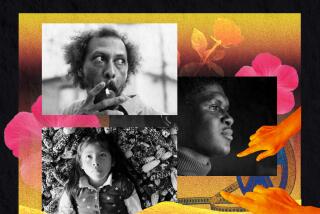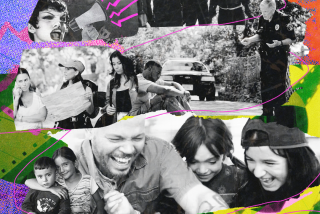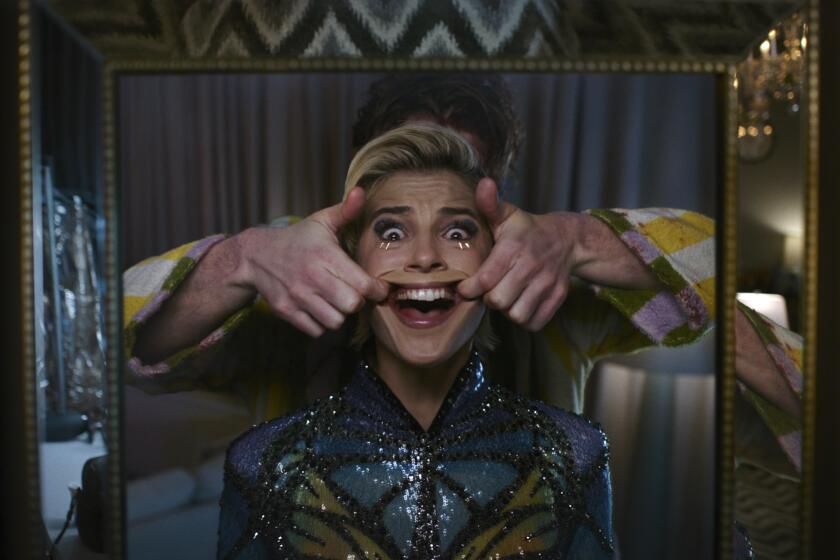A Momâs Tale Kicks Off L.A. Festival
The eighth annual Los Angeles Film Festival opens tonight at the ArcLight Cinerama Dome with a gala presentation of Nicole Holofcenerâs âLovely & Amazing,â starring Brenda Blethyn, Catherine Keener, Emily Mortimer and Raven Goodwin in a story of a mother and her three daughters.
Sponsored by the Independent Feature Project/West, the festival runs through June 29 at various venues.
Among the opening weekend attractions is the clever, amusing and wistful âShowboyâ (Sunset 5, Saturday at 7 p.m.; the Directors Guild, Monday at 5:30 p.m.), in which BBC documentarian Lindy Heymann zeros in on Christian Taylor, a young Englishman trying to make it in Hollywood. No sooner has Heymann started the camera rolling than Taylor is fired from his job as a writer for âSix Feet Under.â
Too proud to let Heymann know the truth, Taylor gets her to follow him to Las Vegas, where ostensibly heâs researching a script but actually is pursuing his dream of becoming a member of a dance chorus. Taylor and Heymann co-directed, and their verisimilitude is as flawless as it is alternately funny and touching.
Slim, curly-haired and handsome, Taylor has sensational charisma even if heâs not as buff as the professional dancers whose ranks he craves to join. Included are knockout cameos by Alan Ball, Whoopi Goldberg and Siegfried & Roy.
Thomas Allen Harrisâ 1996 documentary âVintage: Families of Values,â a vibrant account of the experiences of three sets of gay African American siblings, was beautiful, heartfelt and tonic in its effect, a description that also fits his newest work, âE Minha Cara/Thatâs My Faceâ (Sunset 5, Saturday at 4:45 p.m.; the DGA, June 28 at 5 p.m.)
It documents Harrisâ cultural identity and spiritual searches in the form of a shimmering collage of images of his New York childhood and his experiences in Tanzania with his mother and brother, culminating in Salvador de Bahia, Brazil.
Harris has drawn from home movies, family photographs, and even his grandfatherâs proud recording of TV images of black leaders and celebrities in the 1960s.
On his odyssey, Harris not surprisingly encounters contradictions and complexities, but he lovingly embraces them all in his desire to connect with an African cultural and religious heritage.
Sure to rank among the festivalâs strongest offerings, Christopher Scott Cherotâs âGâ (DGA, Wednesday at 9:45 p.m.; the Sunset 5, June 27 at 5 p.m.) is a boldly imaginative and strikingly successful reworking of F. Scott Fitzgeraldâs âThe Great Gatsby,â starring Richard T. Jones as a suave, powerful rap mogul who has built an ultramodern estate in the Hamptons as a display of his success. But he longs for his lost love from college days, a beautiful woman (Chenoa Maxwell), who not believing he would amount to anything, ditched him for a financier (Blair Underwood).
Now that the mogul has become a nearby neighbor, she realizes her mistake. Class, money, unrequited passion, the treacherousness of the American Dream and fate--all that concerned Fitzgerald emerges here in this assured, sophisticated and stylish film that plays rap numbers against Bill Contiâs timelessly elegant score.
For his irresistible documentary âSpellboundâ (Sunset 5, Monday at 7:30 p.m.; DGA, Wednesday at 5 p.m.), filmmaker Jeff Blitz followed eight kids in their early teens from widely differing backgrounds and locales through their regional competitions all the way to Washington, D.C., for the National Spelling Bee.
Itâs easy to want all eight to win, especially youngsters such as Angela, daughter of a Mexican cowboy who entered the country illegally and who doesnât speak English after 20 years in the U.S. Itâs heartwarming to see so many first-generation U.S. children participating in so American a tradition and discovering a sense of community with other kids as bright and focused as they are. (866) FilmFest.
*
The Warhol on Screen festival continues Friday at 7 p.m. at the Pacific Design Center with âOuter and Inner Spaceâ (1965). Clearly, Warhol perceived a discrepancy between the physical beauty of his doomed superstar Edie Sedgwick and her inner conflict when he decided to videotape her talking, then film her facing her previously taped image, which we see on a TV set on a table behind her.
When this 66-minute segment is presented in split screen, reducing the running time by half, with the latter part projected on the left side of the screen, we get an even more intensified sense of Sedgwickâs fragmented personality as she is confronted with her own image and words.
What a radiant natural screen presence was Sedgwick, whose perfect diction reveals her aristocratic ancestry, and whose dazzling smile and charming personality recall the young Elizabeth Taylor. And what a Hollywood screen test Warholâs footage could have been. Indeed, the shimmering image of Sedgwick on the video screen recalls that famous clip of the younger Gloria Swanson from âQueen Kellyâ quoted in âSunset Boulevard.â
Unintentionally or not, âOuter and Inner Space,â which is screening as part of the Museum of Contemporary Artâs âAndy Warhol Retrospective,â has a muddied soundtrack, but in a way that is sadly appropriate. As Sedgwick prattles on, enough of her talk can be heard to suggest that she was trying to make sense of her life. But neither she nor others listened to her closely enough to save her from the drugs that left her personality vacant but her beauty intact, and which finally claimed her life in 1971 at age 28.
Much has been written about the implications for the possibilities of mixed media posed by âOuter and Inner Space,â but surely it is more important as a portrait of a beautiful woman with the touching vulnerability of a Marilyn Monroe.
Also screening Friday is the 66-minute âThe Life of Juanita Castroâ (1965), in which the family of Fidel Castro, played by Factory regulars, poses for a formal group portrait while playwright Ronald Tavel, who would become a frequent Warhol collaborator, gives the various characters lines to recite.
The central figure is Fidelâs sister Juanita, played by pioneer underground filmmaker Marie Menken, who is not happy with her brotherâs Communist dictates. Fidel, his brother Raul and Che Guevara are all played by women, none of whom is in drag. The effect is amusingly subversive even though the film seems interminable.
Thereâs more of Edie Segwick in Wednesdayâs 7 p.m. screening. In the 33-minute âRestaurantâ (1965), Sedgwick seems lively and alert in a way nearly unique in a Warhol film as she participates in a dinner party with several friends at her favorite restaurant, LâAvventura. In the 66-minute âSpaceâ (1965), a vivacious Sedgwick easily dominates a Factory scene in which Tavel attempts to give lines to Factoryites for eight distinct playlets, a most likely deliberate exercise in futility that quickly lapses into a food-throwing free-for-all. (213) 621-1745.
*
âRevenge of the Japanese Outlaw Masters,â the American Cinemathequeâs fourth annual survey of Japanâs goriest, edgiest filmmakers, runs Friday through Wednesday at the Egyptian. (See story, page 34.) (323) 466-FILM.
*
Note: Josef von Sternbergâs classic groundbreaking gangster picture âUnderworld,â which won Ben Hecht the first Oscar for best original story, stars Clive Brook, Evelyn Brent, George Bancroft and Larry Semon. It screens at the Silent Movie Theatre Friday and Saturday at 8 p.m. and Sunday at 1 and 4 p.m. (323) 655-2520.
More to Read
Only good movies
Get the Indie Focus newsletter, Mark Olsen's weekly guide to the world of cinema.
You may occasionally receive promotional content from the Los Angeles Times.










